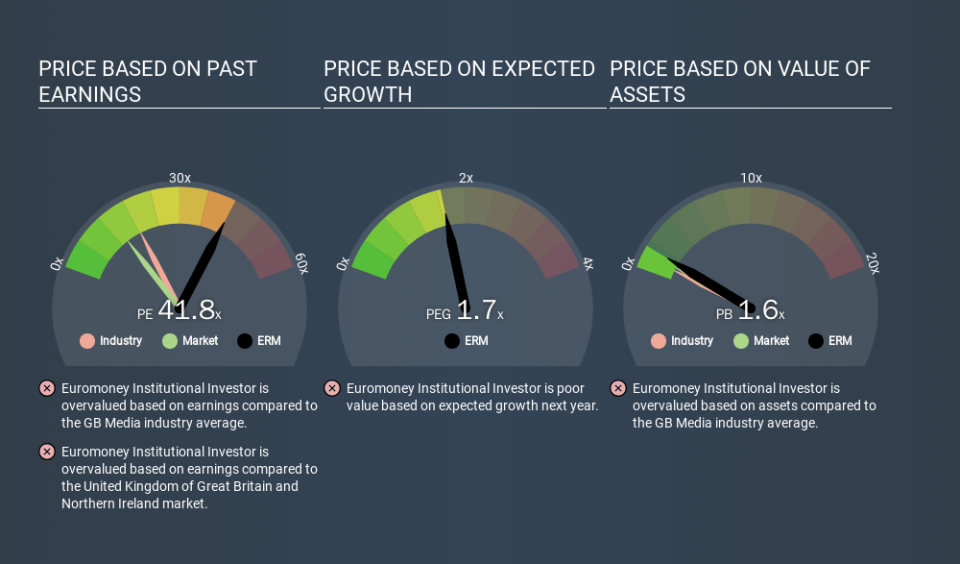A Sliding Share Price Has Us Looking At Euromoney Institutional Investor PLC's (LON:ERM) P/E Ratio

To the annoyance of some shareholders, Euromoney Institutional Investor (LON:ERM) shares are down a considerable 36% in the last month. That drop has capped off a tough year for shareholders, with the share price down 37% in that time.
All else being equal, a share price drop should make a stock more attractive to potential investors. In the long term, share prices tend to follow earnings per share, but in the short term prices bounce around in response to short term factors (which are not always obvious). The implication here is that long term investors have an opportunity when expectations of a company are too low. One way to gauge market expectations of a stock is to look at its Price to Earnings Ratio (PE Ratio). A high P/E implies that investors have high expectations of what a company can achieve compared to a company with a low P/E ratio.
See our latest analysis for Euromoney Institutional Investor
How Does Euromoney Institutional Investor's P/E Ratio Compare To Its Peers?
Euromoney Institutional Investor's P/E of 41.79 indicates some degree of optimism towards the stock. The image below shows that Euromoney Institutional Investor has a higher P/E than the average (18.7) P/E for companies in the media industry.
Euromoney Institutional Investor's P/E tells us that market participants think the company will perform better than its industry peers, going forward. Clearly the market expects growth, but it isn't guaranteed. So further research is always essential. I often monitor director buying and selling.
How Growth Rates Impact P/E Ratios
Probably the most important factor in determining what P/E a company trades on is the earnings growth. If earnings are growing quickly, then the 'E' in the equation will increase faster than it would otherwise. And in that case, the P/E ratio itself will drop rather quickly. Then, a lower P/E should attract more buyers, pushing the share price up.
Euromoney Institutional Investor shrunk earnings per share by 70% over the last year. But over the longer term (3 years), earnings per share have increased by 1.9%. And EPS is down 21% a year, over the last 5 years. This might lead to muted expectations.
A Limitation: P/E Ratios Ignore Debt and Cash In The Bank
Don't forget that the P/E ratio considers market capitalization. Thus, the metric does not reflect cash or debt held by the company. Theoretically, a business can improve its earnings (and produce a lower P/E in the future) by investing in growth. That means taking on debt (or spending its cash).
Such expenditure might be good or bad, in the long term, but the point here is that the balance sheet is not reflected by this ratio.
So What Does Euromoney Institutional Investor's Balance Sheet Tell Us?
Since Euromoney Institutional Investor holds net cash of UK£50m, it can spend on growth, justifying a higher P/E ratio than otherwise.
The Verdict On Euromoney Institutional Investor's P/E Ratio
Euromoney Institutional Investor trades on a P/E ratio of 41.8, which is multiples above its market average of 13.9. Falling earnings per share is probably keeping traditional value investors away, but the net cash position means the company has time to improve: and the high P/E suggests the market thinks it will. What can be absolutely certain is that the market has become significantly less optimistic about Euromoney Institutional Investor over the last month, with the P/E ratio falling from 65.7 back then to 41.8 today. For those who prefer to invest with the flow of momentum, that might be a bad sign, but for a contrarian, it may signal opportunity.
When the market is wrong about a stock, it gives savvy investors an opportunity. People often underestimate remarkable growth -- so investors can make money when fast growth is not fully appreciated. So this free report on the analyst consensus forecasts could help you make a master move on this stock.
But note: Euromoney Institutional Investor may not be the best stock to buy. So take a peek at this free list of interesting companies with strong recent earnings growth (and a P/E ratio below 20).
If you spot an error that warrants correction, please contact the editor at editorial-team@simplywallst.com. This article by Simply Wall St is general in nature. It does not constitute a recommendation to buy or sell any stock, and does not take account of your objectives, or your financial situation. Simply Wall St has no position in the stocks mentioned.
We aim to bring you long-term focused research analysis driven by fundamental data. Note that our analysis may not factor in the latest price-sensitive company announcements or qualitative material. Thank you for reading.

 Yahoo Finance
Yahoo Finance 
